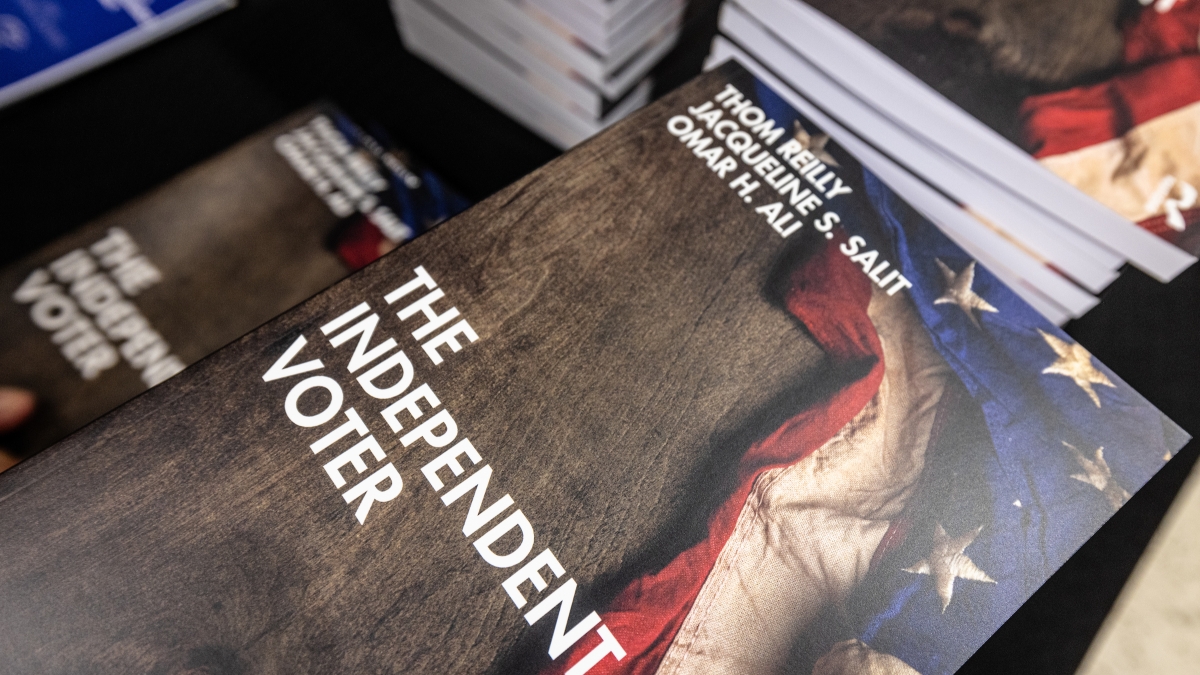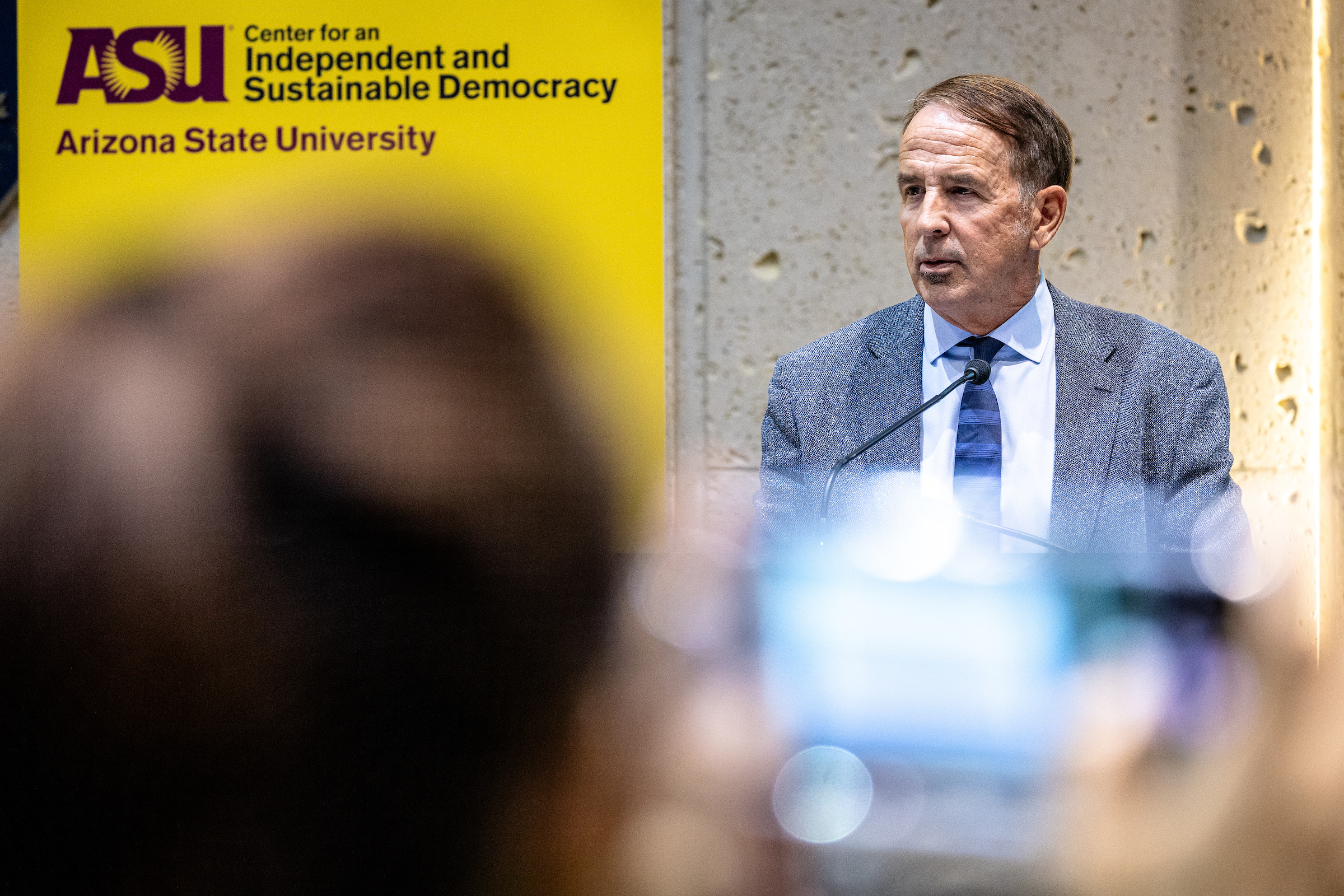Extreme partisan politics and hostility is turning off many American voters, who are increasingly disaffiliating themselves from the two major political parties, according to participants in a forum on Wednesday night.
Political scientists, advocates and citizens gathered for an event titled, “Who Is the Independent Voter?” sponsored by the Center for an Independent and Sustainable Democracy in The College of Liberal Arts and Sciences at Arizona State University.
Nationwide, a recent Gallup poll found that 41% of respondents considered themselves independent, up from about 30% in the early 2000s, while Democrats and Republicans were both at 28%.
Also, 52% of Latinos identify as independents, along with 31% of African Americans, 43% of Asian Americans and 61% of people ages 18 to 24.
“We have a whole generation of young people who don’t belong to one of the parties, and they have no interest in joining the parties,” said Thom Reilly, co-director of the Center for an Independent and Sustainable Democracy and a professor in the School of Public Affairs.
In Arizona, voter registration is distributed roughly one-third each among Republicans, Democrats and independents, with the unaffiliated voters having slightly more.
Reilly said that at one time, political scientists believed that a truly independent voter did not exist because they were secretly partisan. But subsequent research has shown that even if an independent voter “leans” toward one party, they don’t usually vote a straight ticket from election to election.
“The defining feature of independents is that candidates and issues, not party loyalty, drive their choices,” Reilly said.
“Their unpredictability is what gives independents their power and why a deeper understanding of these voters is needed.”
Professor Thom Reilly, co-director of ASU’s Center for an Independent and Sustainable Democracy, speaks during the “Who Is the Independent Voter?” event held Nov. 1 at ASU. Photo by Charlie Leight/ASU News
Jacqueline Salit, a professor of practice in the School of Public Affairs and co-director of the Center for an Independent and Sustainable Democracy, moderated a panel at the event. Among the points raised were:
Independent voters are volatile
“Independent voters are a big category, but they are not homogenous,” said Morris Fiorina, professor of political science at Stanford University.
“Some are closet partisans, some are ideological centrists, some are cross-pressured on issues, some are alienated and some are uninterested. But they are volatile.”
Fiorina said that in the overwhelmingly majority of presidential elections, the winning candidate is the one who carries the independent vote. And these voters are also responsible for the midterm swings in party control, such as when the Republicans suffered many losses in 2022, he said.
“Somebody wins and they take the politics too far to the left or to the right, and the independents do a course correction in the midterms,” he said.
Independents detest partisanship
“(Independent voters) don’t identify with the hostility and anger and conflict they see constantly portrayed in the media,” said Samara Klar, a professor of political science at the University of Arizona.
In fact, her research shows that this group chooses unaffiliation to avoid the taint of partisanship.
“Independents may vote for their favorite party, but they refrain from activities that could betray their true partisanship,” she said.
Independents don’t put political signs in their yards or donate money to candidates, which are the types of support that the two parties depend on.
The system is biased against independents
“In Arizona and across the country, really, independents don’t have a lot of choice but to vote for Republicans and Democrats,” said Keely Varvel, assistant secretary of state in Arizona and chief of staff to Secretary of State Adrian Fontes.
In 1998, Arizona passed a constitutional amendment that allowed independents to vote in primary elections, but they have to request a ballot.
“Everybody else gets a ballot automatically mailed to them, but independents have to make that extra effort. They have to choose a ballot, Democrat or Republican,” she said.
Independents are also not eligible to vote in the “presidential preference” primary elections that are held in March.
“In 2016 you had the Sanders campaign and the Trump campaign actively recruiting independents to vote for them in other states. Those folks weren’t eligible to vote in Arizona, but they showed up and demanded to vote and stood in long lines and they were turned away, and there was a lot of anger and frustration and confusion,” Varvel said.
“And that exists to this day and keeps me up at night.”
It’s also difficult to run as an independent candidate.
“For the U.S. Senate race, you would have to have to have over 43,000 petition signatures to qualify for the ballot as an independent. Democratic and Republican candidates need about 7,000,” she said.
In addition, the two parties control the system of election observers and hand-count audits, shutting out representation of independents.
Trying to reform the system
Some Arizonans are working to change the stranglehold of the two-party system. Chuck Coughlin, CEO of HighGround political consulting firm, is heading an initiative called Make Elections Fair to make ballot access equitable and to legalize ranked-choice voting.
“Open primaries are incredibly popular with the electorate in Arizona,” he said. “The essential qualities we’re trying to articulate is that you treat everybody equally.”
Younger voters overwhelmingly support ranked-choice voting, Coughlin said
“They haven’t been indoctrinated into this binary choice we have now,” he said.
A recent survey by the Center for an Independent and Sustainable Democracy found strong support for a nonpartisan primary system, with 80% of the 1,063 registered voters surveyed endorsing it.
Independents can be the middle ground
“The two-party system is polarized and don’t agree on anything except one thing — to keep the two-party system alive,” said Joe Garcia, executive director of Sí Se Vota Chicanos Por La Causa Action Fund.
“The two parties will work together to make that happen.”
Latinos are more likely to be independent because it’s a young population with a median age of about 26, he said.
“Younger people are tired of a two-party system they see that doesn’t go anywhere. They’ve seen the polarization. They’ve seen the demonization. They’re looking for something else,” Garcia said.
“What’s in that is the great hope to come together as a nation through compromise and talk in that middle ground. That middle ground is the problem-solving mechanism for our nation and our state.”
Veterans embrace the independent mentality
About 59% of veterans are registered as independent.
Eric Bronner, founder of Veterans for Political Innovation, said that’s because many are loath to be perceived as partisan.
“They know their duty is to the Constitution. Their duty is not to a party,” he said.
“It’s a structural flaw. It’s a system-level problem that demands system-level solutions. It’s hard to get people to pay attention because all the oxygen in the room is, ‘Are you red or blue?’”
In 2020, 26 million people were barred from voting in presidential preference primaries by their state rules because they were not affiliated with one of the parties.
“I don’t know the exact number of veterans, but for active-duty military who couldn’t vote for their future commander in chief — we all should be morally outraged by that,” he said.
Why they’re independents
The event included Valley residents who identify as independents.
Ray Kimball of Gilbert said he had been a registered Republican for nearly 30 years, but broke with the party after 2020.
“For me it comes down to loyalty. The major political parties have fundamentally breached that loyalty,” Kimball said. “We heard it in Dr. Klar’s research, the disdain that people have for extreme partisanship, and yet the parties are going to that well over and over again.”
Rose Lavandero of Scottsdale said she became an independent voter at the age of 20.
“I have voted for Republicans as well as Democrats. I didn’t want anyone to tell me how to think and how to vote,” she said.
“I wanted to arrive at the conclusion myself without being aligned to any one party.”
Top photo: The book "The Independent Voter," co-authored by Professor Thom Reilly, co-director of ASU’s Center for an Independent and Sustainable Democracy, was available for audience members who attended a panel discussion on “Who Is the Independent Voter?” on Wednesday, Nov. 1, at ASU's Armstrong Hall on the Tempe campus. Photo by Charlie Leight/ASU News
More Law, journalism and politics
Can elections results be counted quickly yet reliably?
Election results that are released as quickly as the public demands but are reliable enough to earn wide acceptance may not always be possible.At least that's what a bipartisan panel of elections…
Spring break trip to Hawaiʻi provides insight into Indigenous law
A group of Arizona State University law students spent a week in Hawaiʻi for spring break. And while they did take in some of the sites, sounds and tastes of the tropical destination, the trip…

LA journalists and officials gather to connect and salute fire coverage
Recognition of Los Angeles-area media coverage of the region’s January wildfires was the primary message as hundreds gathered at ASU California Center Broadway for an annual convening of journalists…



